This article will be of interest to those who want to work in a specific custom software development niche. And also for those who are already doing it and thinking about ways to promote highly specialized bespoke services using b2b content marketing.
Svetlana Gordiyenko, with 9+ years of marketing experience in IT outsourcing services, launched marketing from scratch in the outsourcing department of XB Software. Member of the Chartered Institute of Marketing (MCIM), UK, and an IT marketing consultant. Currently, Svetlana is the Head of Marketing at InData Labs. In less than a year, she was able to organize b2b content marketing in the company in such a way that the US and UK traffic to the company’s website quadrupled. At the same time, the number of marketing qualified leads (MQL) has increased by 21%, while their cost has decreased by 25%. As a result, the company gets 35-40 MQL monthly, 25-30 out of which are graded as sales qualified leads (SQL) by the Sales department. And 10-12 of them turn into sales opportunities (potential contracts). Let’s figure out how they organized their work.
What is an MQL?
For us, MQL (a marketing qualified lead) is a lead who matches our buyer personas and sends us a service request. We receive most of the leads through the website forms from the organic channels. Other lead sources bring us a small number of requests. Thus, the b2b content brings us leads of the highest quality.
At the same time, we invest up to $5,000 per month in search advertising to promote our landing pages and about $1,500 for link building to get top rankings for our keywords. We do link building in the following way: we select trustworthy resources, write articles, or buy anchored links in published articles.
We add quotes by our experts to the articles to add trust and value to the publication. But in terms of lead generation, these activities are more supportive and help increase InData Labs brand awareness.
How We Set Up B2B Content Marketing Processes
When I joined the company in early 2019, there were no efficient marketing processes. Marketing activities were chaotical, and I had to build up everything from scratch, hire people and assign tasks. Some leads had already been generated by that time, but I was challenged to define the focus and establish a consistent flow of leads in focus areas, which I had to suggest to the company.
Therefore, at first, I focused on internal and external audits of the company, client portfolio, and market analysis, and created a marketing strategy for the company.
CRM Integration
I implemented Asana (by the way, they offer a free plan for small teams), and chose a new CRM. The previous one was inconvenient for the sales managers who stored data in Google spreadsheets instead.
We integrated the CRM with the website and made all the necessary setups for leads from target regions to get immediately into the CRM with all necessary data – channel, landing page from which they converted, the keyword (if leads came from paid advertising).
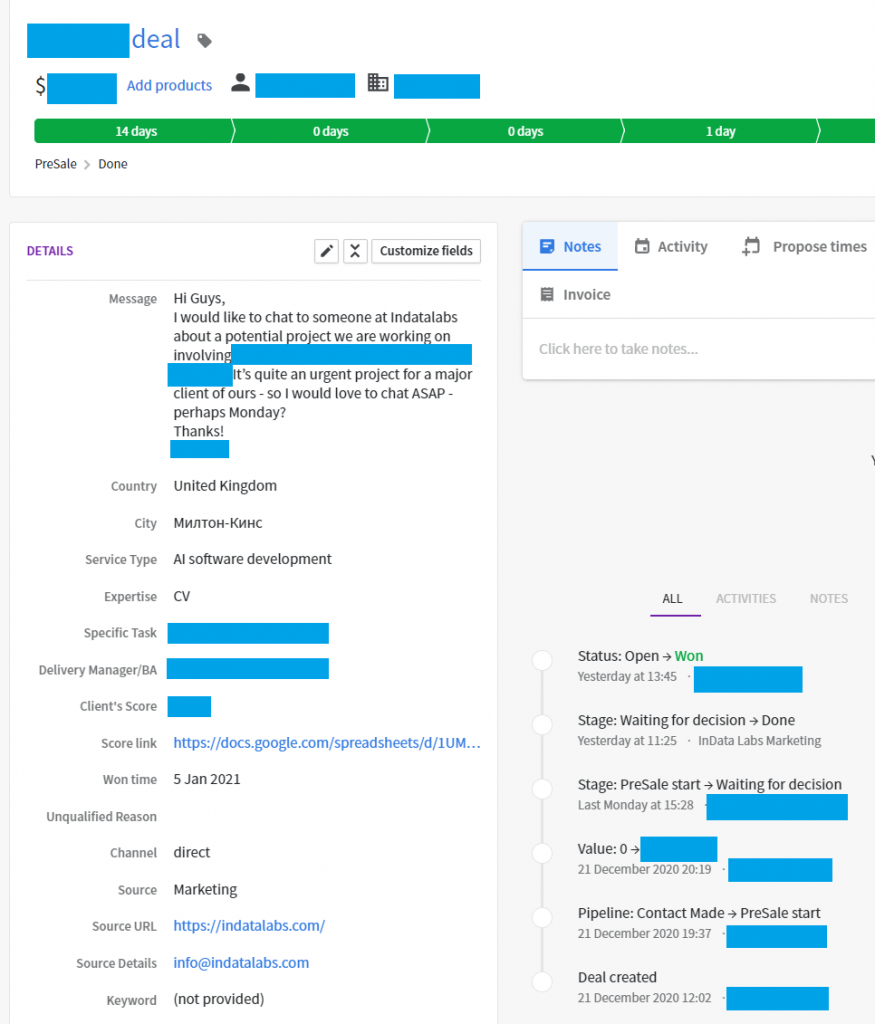
Deal example from CRM
Since the company specializes in Data Science (and doesn’t have frontend and backend developers), there were no in-house designers and website developers to work with the corporate site, and the company worked with freelancers. As a result, we employed such specialists on a full-time basis.
Now the marketing team consists of a b2b content marketer, a digital marketer who deals with PPC advertising and marketing automation, a copywriter, a designer, a website developer, and an external SEO specialist.
I organized work in such a way that every month starts with a retrospective when each team member reviews his/her work and prepares a written report with analytics and recommendations.
Content Plan
Based on them, I make a tactical action plan and a content plan with deadlines for the next month.
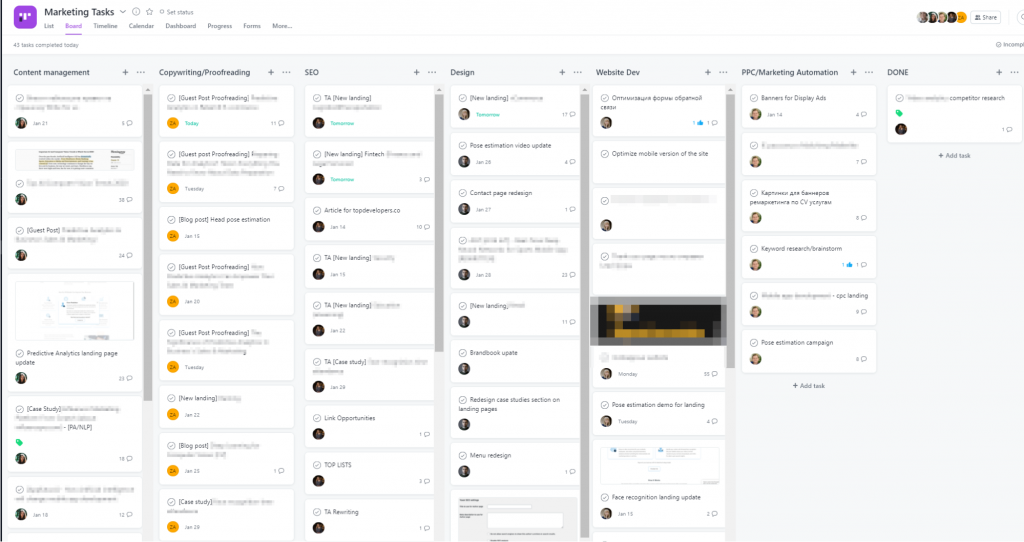
An example of organizing work on content in Asana
How We Prepare B2B Content
On the whole, our b2b content marketing activities are the same as in other companies (publishing landing pages, case studies, articles). The key difference is that we actively publish infographics and reports with expert opinions in the field of Data Science. We have a very intense guest blog posting right now. We get lots of inquiries for guest posting in our blog from third-party copywriters.
All the website content is mainly handled by a team of 5 people: content marketer, copywriter, SEO specialist, designer, and website developer. They are all in-house employees except for the SEO specialist.
However, our SEO specialist works with us full-time and does only our tasks, so she is involved in the process in the same way as the in-house employees.
All work with content is divided into several areas:
- Writing articles for our blog (sometimes for third-party resources)
- Preparing reports and infographics for the “White Papers & Researches” section.
- Creating new landing pages or updating the existing ones.
- Social media posting
Social Media Groups
We also work with thematic communities (for example, “Artificial Intelligence and Business Analytics (AIBA) Group”, “Artificial Intelligence, Machine Learning, Robotics, Big Data, Blockchain, and Bitcoin” in Linkedin) and purchase articles on third-party platforms for SEO needs.
The company has a plan for a new publication every Tuesday and Thursday: it can be either a blog post, a new/updated landing page, a new report, or a white paper.
We publish social media posts twice a week: on Tuesday and Thursday. It can be either an announcement of our new publications on the website or regular posts.
I have a content plan with ideas for articles and other content. This is a list of potentially interesting topics.
In the first days of each month, we get together and choose topics from the list for the next month, based upon which the action plan is created.
At the same time, we have both short-term activities, which involve preparation of articles and updates of landing pages, and long-term ones, for example, the creation of white papers. It can take several months to get a white paper ready.
How and Why We Make Reports
To sell high-tech projects is not an easy job. There are difficulties even with some clients not allowing us to publish anonymized case studies describing their projects. They are afraid that their competitors will read such material and will try to implement an idea in their projects. Sometimes they even ask to remove information about some technological formulations, although their application can be a common practice.
Therefore we coordinate such publications with our customer, whose project we’d like to describe. Now we have about 10 such use cases awaiting customer approval. We pay lots of attention to creating reports where we can tell about our expertise and increase trust in the brand.
And thanks to the increase in brand awareness, we get high-quality leads from brand searches.
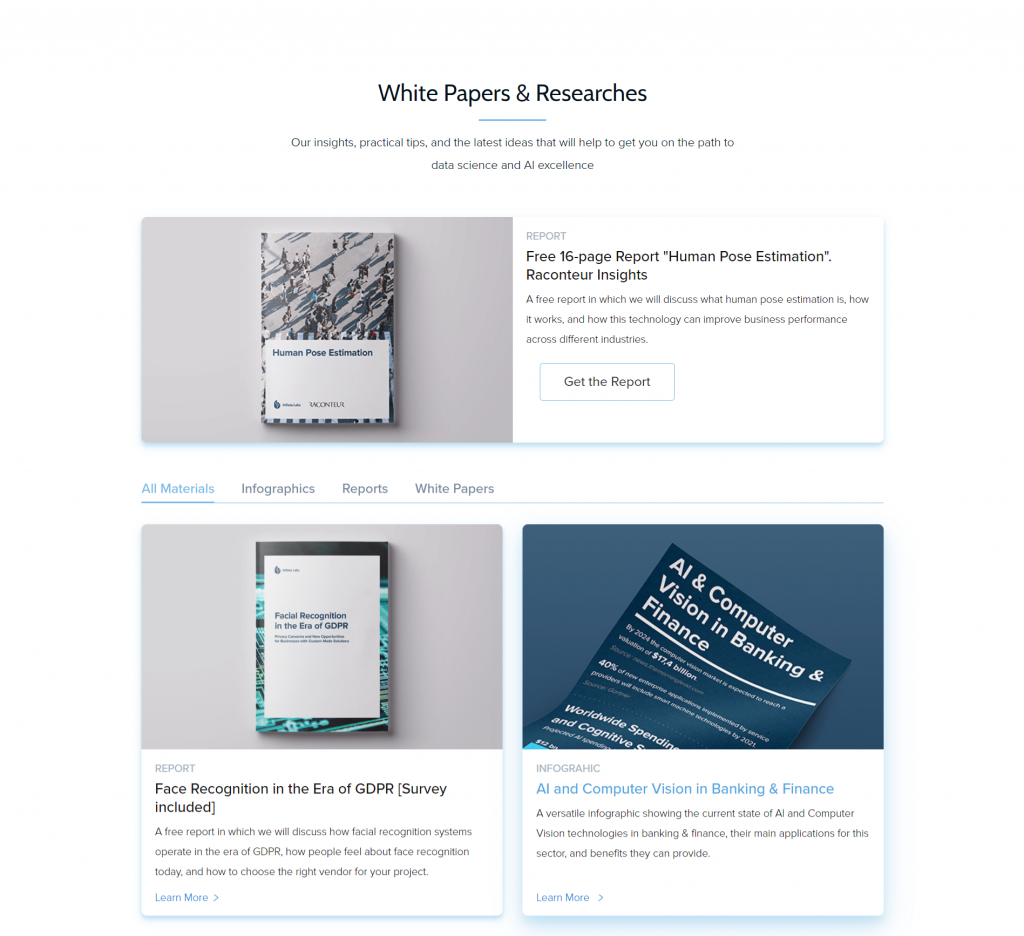
Research Papers section example on the InData Labs’ website
To download a report or white paper, a client needs to leave enough data about himself.
Based on this information, we include the person in the appropriate email cohort and send them a sequence of emails to nurture leads for our sales department.
Access to Technical Specialists
We make high-quality materials indeed because our copywriter has unlimited access to the technical specialists of the company. So, she can clarify things and ask questions as much as necessary.
Many companies are not ready to spend their developers’ time preparing articles.
While we invest our developers’ time in b2b marketing content creation, that’s why all reports, all analytics, and infographics are technically correct, interesting, and useful for potential customers.
Moreover, when the material is ready, the copywriter gives it to the technical specialists to review and give their comments. Sort of double quality control.
We distribute reports through our mailing list, in thematic communities, on Reddit, and LinkedIn. The main channel is LinkedIn, of course.
How We Worked with a Digital Agency
We had an interesting experience working with a digital agency from the United Kingdom in the preparation and distribution of a digital report.
We spent more than $17,000 for the report and its distribution on LinkedIn prepared a draft material with our lead engineer and handed it over to the agency. They proofread and improved it, added more information, and published it on their website. Then they launched a campaign and sent leads to us.
There were a lot of people interested in the report, but for us, those leads turned out to be common leads, not MQLs.
We created a PDF version of this report and published it on the website, and almost immediately got a high-quality lead, who read the material and wanted to discuss his project.
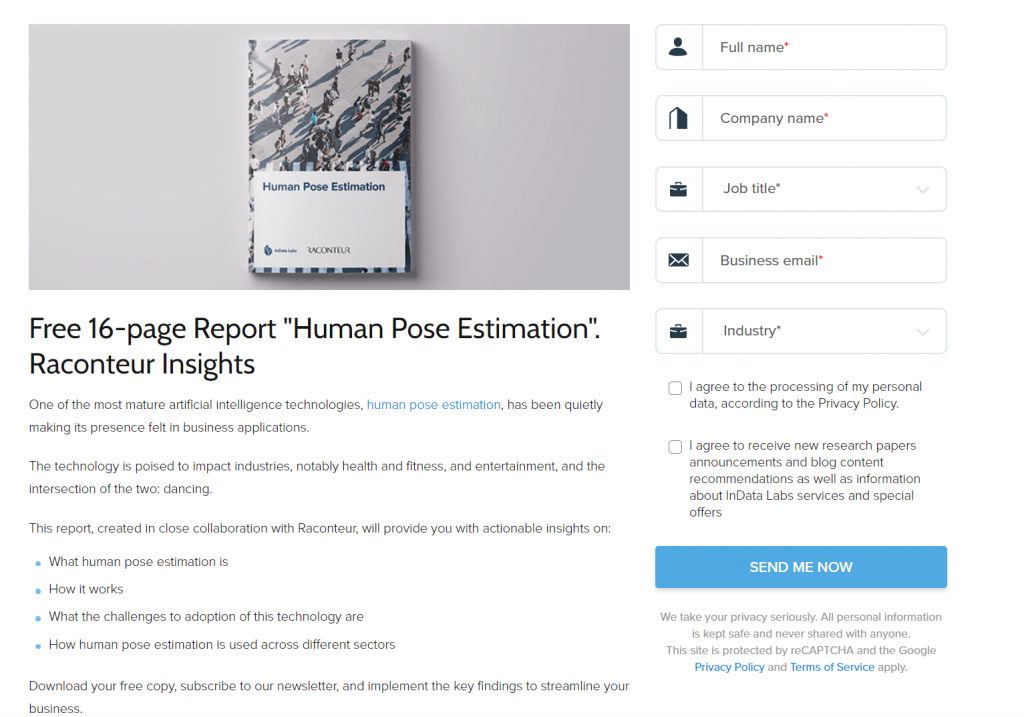
An example of a report page
In general, the sum spent for this campaign was unreasonably high, but the effect was long-lasting. Together with the rest of our activities, we still get leads interested in the advertised technology.
How We Organize Our Email Lists
I’ll tell you how our subscriptions work.
We have several email segments:
- Blog subscribers: we send them updates once a month. Anyone can get into this segment, so we just send them monthly news and updates. But we do not conduct any selling activities for them.
- Leads who download our reports and white papers: these are already warmer users, so we request much more information from them from the start. This helps us establish better communication with them and send them more relevant emails.
By target segments, our total number of subscribers is 1,000+. We set up sequences of emails for lead nurturing.
One segment includes from 10 to 200 users, where we unite subscribers according to the following principle: the user downloaded the material dedicated to a certain technology (the user must indicate his industry to get the material).
Then we send them materials (case studies, reports, infographics, etc.) on the requested and related technologies in his/her industry.
Emails don’t bring immediate results, but they are part of the work over the InData Labs’ brand.
How We Attract Contributors
For our website blog, we write both ourselves and also accept articles from contributors. We do not pay them for publications. They send their articles, which they want to publish on our website to get more traffic, PR, and links.
Our promotion tactics include active link building. That means that along with SEO we also increase the company’s brand awareness.
Thanks to this tactic, we were flooded with proposals to publish articles in Data Science in our blog.
Contributor Guidelines
That’s why we have published guest contributor guidelines on the company’s website.
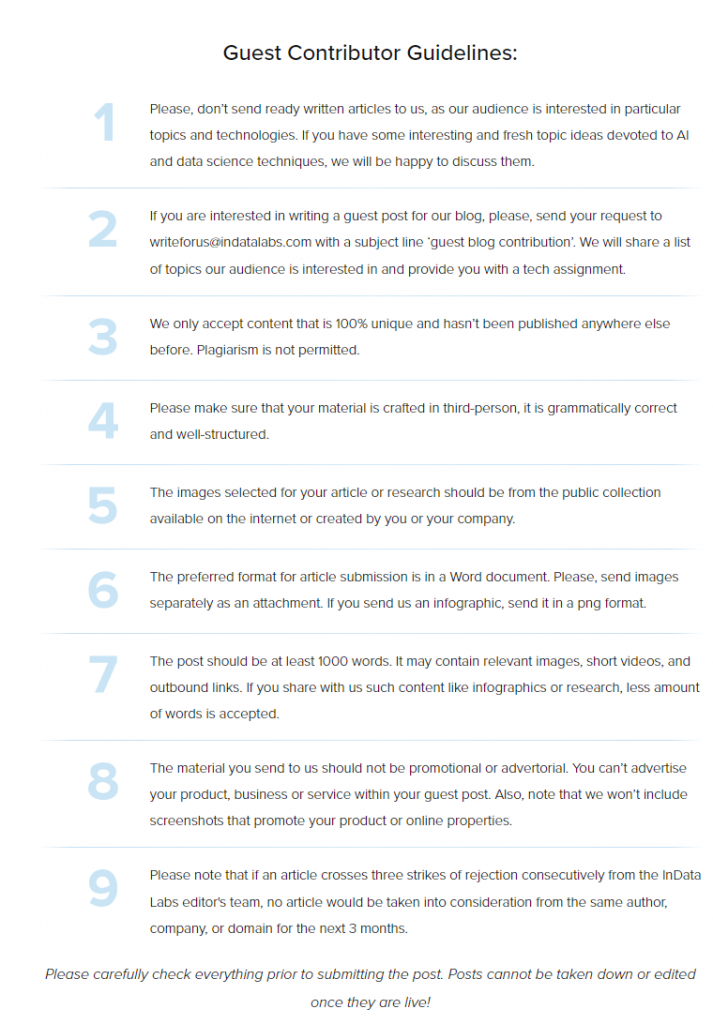
An example of guest contributor guidelines
In addition to the proposals that we receive, we send a list of topics that are of interest to us. We suggest guest copywriters write an article based on our content recommendations.
Our SEO specialist prepares content recommendations.
At first, we accepted articles from all copywriters. But recently we started to filter out those with backlinks to essay writing services.
Now IT companies are actively writing to us: they better understand the subject area and create better materials. Plus, this increases the expertise of the blog.

An example of a guest article in the InData Labs’ blog
In general, it’s mutually beneficial cooperation: we get high-quality content, and contributors get publications and reach.
At the same time, it is important to understand that we work with contributors on a non-systematic basis.
Though starting from 2020 we get offers from contributors quite often, we publish far not all of them.
Therefore, we still write most of the blog articles on our own.
In general, by the efforts of a small team, we managed to build content marketing that generates leads and contracts.
At the same time, you can scale the entire system, when required, and generate even more MQLs in the future.



